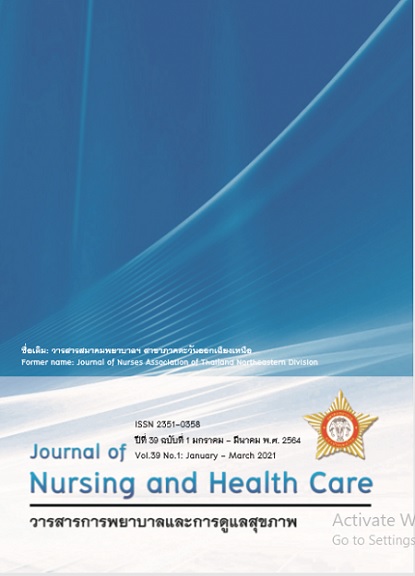พยาบาลควบคุมการติดเชื้อกับบทบาทการจัดการควบคุมการระบาดของ โรคโควิด 19 ในหน่วยบริการสุขภาพ
คำสำคัญ:
โควิด 19, การป้องกันและควบคุม, พยาบาลควบคุมการติดเชื้อบทคัดย่อ
การแพร่ระบาดของโรคติดเชื้อไวรัสโคโรนา 2019 หรือ โรคโควิด 19 ส่งผลกระทบต่อระบบสุขภาพของทุกประเทศทั่วโลก กระทรวงสาธารณสุขของไทยประกาศให้เป็นโรคติดต่อร้ายแรง อันดับที่ 14 โดยกำหนดมาตรการเพื่อควบคุมและป้องกันไม่ให้เกิดการแพร่กระจายเชื้อในวงกว้าง บุคลากรสุขภาพที่มีบทบาทอย่างมากในสถานการณ์การแพร่ระบาดของโรคที่รุนแรงเช่นนี้ พยาบาลควบคุมการติดเชื้อคือกำลังสำคัญที่ทำหน้าที่ในการจัดการควบคุมการระบาดของโรคโควิด 19 ในหน่วยบริการสุขภาพ ซึ่งบทความนี้นำเสนอบทบาทของพยาบาลควบคุมการติดเชื้อ 9 ประเด็นหลัก ประกอบด้วย 1) พัฒนาระบบการควบคุมและป้องกันการติดเชื้อ 2) วางแผนการดูแลผู้ป่วยที่มีปัญหาซับซ้อน 3) ประสานการดำเนินงานเพื่อการควบคุมและป้องกันการติดเชื้อ 4) สร้างเสริมพลังอำนาจให้กับพยาบาลและบุคลากรสุขภาพ 5) ให้คำปรึกษาทางคลินิก 6) สร้างการเปลี่ยนแปลงโดยใช้ภาวะผู้นำ 7) ตัดสินใจเชิงจริยธรรม 8) ใช้หลักฐานเชิงประจักษ์สู่การปฏิบัติทางการพยาบาล และ 9) จัดการและประเมินผลลัพธ์ด้านการบริการ พยาบาลควบคุมการติดเชื้อคือบุคคลสำคัญในการขับเคลื่อนงานควบคุมการระบาดของโรคโควิด 19 เพื่อให้บรรลุเป้าหมายของการบริการสุขภาพ คือความปลอดภัยของผู้รับบริการและคุณภาพการบริการ
Downloads
เอกสารอ้างอิง
Application. Ann Intern Med 2020; doi: 10.7326/M20-0504.
2. Notification of the Ministry of Health. Names and key symptoms of dangerous communicable diseases (No.3) [internet]. 2020 [cited 2020 May 6]; Available from:
https://ddc.moph.go.th/uploads/files/10020200514102630.PDF
3. Manmana S, Iamsirithaworn S, Uttayamakul S. Coronavirus disease-19 (COVID-19). Journal of Bamrasnaradura Infectious Diseases Institute 2020; 14(2): 1-10.
4. Ratnarathon A. Coronavirus infectious disease-2019 (COVID-19): a case report, the first patient in Thailand and outside China. Journal of Bamrasnaradura Infectious Diseases Institute
2020;14(2): 11-18.
5. World Health Organization. Guidelines on core components of infection prevention and control programmed at the national and acute health care facility level. Geneva: World Health
Organization; 2016.
6. World Health Organization. Minimum requirements for infection prevention and control. Geneva: World Health Organization; 2019.
7. World Health Organization. Global surveillance for COVID-19 caused by human infection with COVID-19 virus: interim guidance. Geneva: World Health Organization; 2020.
8. Tran K, Cimon K, Severn M, Pessoa-Silva CL, Conly J. Aerosol generating procedures and risk of transmission of acute respiratory infections to healthcare workers: a systematic review.
LoS One 2012;7: e35797.doi: 10.1371/journal.pone.0035797.Epub 2012 Apr 26.
9. World Health Organization. Infection prevention and control during health care for probable or confirmed cases of Middle East respiratory syndrome coronavirus (MERS-CoV) infection:
interim guidance. Geneva: World Health Organization; 2016.
10. Adams J, Bartram J, Chartier Y, editors. Essential environmental health standards in health care. Geneva: World Health Organization; 2008.
11. Chaichumpoo P. Infection control in the community hospital: role of Thai infections disease and infection control advance practice nurse. Thai Journal of Nursing and Midwifery Practice
2015; 1(2): 55-60.
12. Picheansathian W. Development of Thai infections disease and infection control advance practice nurse. Thai Journal of Nursing and Midwifery Practice 2014; 1(1): 23-30.
13. Niyomwit K, Prachusilpa K. Competency of infectious control ward nurse. Journal of The Police Nurse 2015; 7(1): 153-165.
14. Government gazette. Announcement of the Nursing Council on scope and competencies of advanced nursing practitioners in various fields [internet]. 2020 [cited 2020 August 10];
Available from: http://www.ratchakitcha.soc.go.th/DATA/PDF/2552/E/016/28.PDF
15. Atkinson J, Chartier Y, Pessoa-Silva CK, Jensen P, Li Y, Seto WH, editors. Natural ventilation for infection control in health-care settings. Geneva: World Health Organization; 2009.
16. Sungkeaw S, Harnirattisai T, Srisatidnarakul B. Registered Nurses’ Competency in Caring for Emerging Infectious Diseases. Journal of Thailand Nursing and Midwifery Council 2020;
35(3): 69-86.
17. Thailand Nursing and Midwifery Council. Practice guidelines for the control and prevention\ of Coronavirus 2019 for professional nursing and midwifery [internet]. 2020 [cited 2020 May 6]; Available from: https://www.tnmc.or.th/images/userfiles/files/Covid-Update01042020.pdf
18. The Healthcare Accreditation Institute (Public Organization). Hospital and health services standards issue 4. The Healthcare Accreditation Institute (Public Organization). Bangkok; 2017.
19. Christraksa W, Chetchaovalit T. The Role of the Community Psychiatric Nurses in the Elderly living with Spiritual Distress: Spiritual Dimension. Journal of Nursing and Health Care 2020;
36(2): 6-14.
20. Niamwan C, Reangsan D, Kankarn W. The Professional Nurses’ Competencies in Nursing Patients Using Mechanical Ventilation. Journal of Nursing and Health Care 2020; 38(1): 6-14.
21. Unahalekhaka A. Best Practice Guideline for Prevention of Multidrug Resistant Organisms Transmission in Hospitals. Chiangmai: Ming Muang Printing; 2011.



